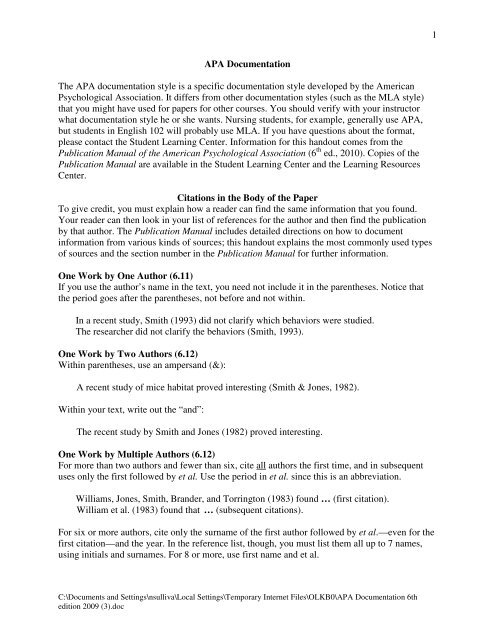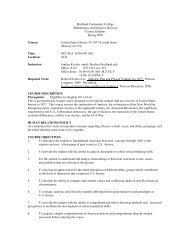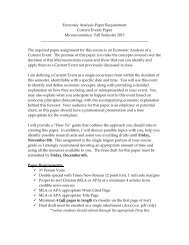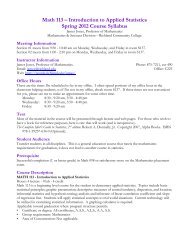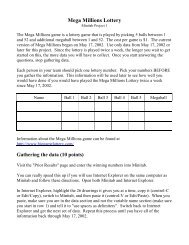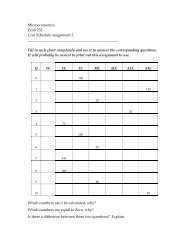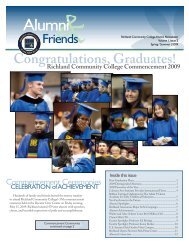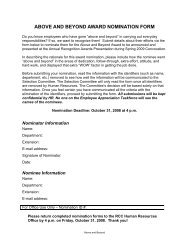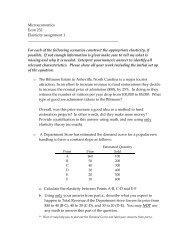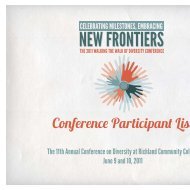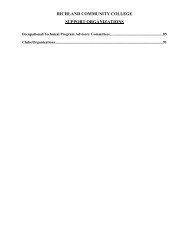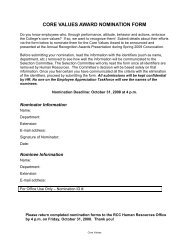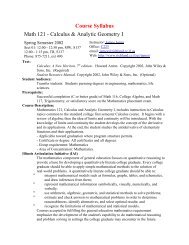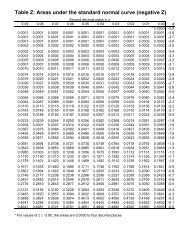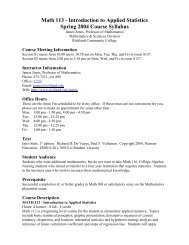APA Style Sheet created by Richland's English Faculty
APA Style Sheet created by Richland's English Faculty
APA Style Sheet created by Richland's English Faculty
Create successful ePaper yourself
Turn your PDF publications into a flip-book with our unique Google optimized e-Paper software.
3The City Council will be voting on this next month (J.O. Reiss, personal communication,April 19, 1983)Direct Quotation (6.03)The Publication Manual distinguishes between direct quotations of more than or fewer than 40words. In either case, the quotation must match the original source exactly. These are cited in thesame way as the previous examples except include the page from which you took the quotation:Smith (1981) found that "the effect disappeared within minutes" (p. 311).The author stated, "The effect disappeared within minutes" (Smith, 1981, p. 311).The author stated, "The effect disappeared within minutes" (Smith, 1981, p. 311), but he didnot say which effect.Long Quotations of More than 40 Words (6.03)Do not use long quotations often in a paper. Summarize or paraphrase instead. If you must use along quotation of more than 40 words, follow these guidelines:1. Indent five spaces or about 1/2" from the left margin, in the same position as a newparagraph. Begin here for the first paragraph. For subsequent paragraphs, indent anadditional five spaces for the first line.2. Type the entire quotation double-spaced.3. Do not enclose long quotations in quotation marks.4. When quoting, always give the author, year, and page number. You may include authorand year in the text or in the parentheses but not in both places.5. For long quotations, closing punctuation (such as the final period) comes before theparenthetical citation.Example:Smith (1982) found the following:The "placebo effect," which had been verified in previous studies,disappeared when behaviors were studied in this manner. Furthermore, thebehaviors were never exhibited again, even when real drugs wereadministered. Earlier studies were clearly premature in attributing theresults to a placebo effect. (p. 276)C:\Documents and Settings\nsulliva\Local Settings\Temporary Internet Files\OLKB0\<strong>APA</strong> Documentation 6thedition 2009 (3).doc
4Direct Quotation of Online Material without Pagination (6.05)Because many online sources do not provide page numbers, use paragraph numbers in place ofpage numbers. Use the abbreviation para.Smith (2003) explains that research in genetic engineering “needs extensive monitoringto reduce opportunities for error” (para. 7).Other citation options include using headings instead of paragraph numbers. See section 6.05 forclarification.Note: When paraphrasing, provide a page number or a paragraph number, especially when itwould help a reader locate the relevant passage in a long or complex text. (6.04)Indirect Sources, Citing an Idea Someone Else Has Cited:Try to find the original source because the publication you have may be incorrect. If you cannot,show that it is an indirect quotation in case the source you are using has cited incorrectly.Here is a scenario: You want to cite Betty Johnson, but you found the quotation <strong>by</strong> her in anarticle <strong>by</strong> Ned Beatty. You can't find the original source <strong>by</strong> Johnson. Put only Beatty within thelist of references. In other words, don't include anything in the list of references that you haven'tactually seen. In the text, however, show that you are actually citing Johnson:Johnson's study (cited in Beatty, 1982) …Other examples are listed in the <strong>APA</strong> Publication Manual. Please use it whenever you havequestions. The Manual also offers guidelines for specific mechanical requirements in areas suchas abbreviations, numbers, capitalization, and series variations. Ask questions if you areuncertain.C:\Documents and Settings\nsulliva\Local Settings\Temporary Internet Files\OLKB0\<strong>APA</strong> Documentation 6thedition 2009 (3).doc
5Preparing the List of ReferencesIn the reference list, include only what you have actually cited in the text. Therefore, if you readsomething but never cited the author in the paper, do not include the reference in the list.Citations in the text and the reference list must agree. Also, remember that personalcommunications such as letters, e-mails, and telephone calls that may be cited in the paper do notappear in the reference list.Double-space the reference list. Single space after all punctuation. Type the first line of eachentry against the left margin, and indent the following lines five (5) spaces; this format is calledhanging indentation. However, in some cases you would create the reference list using aparagraph structure. Check with your instructor to determine which format is appropriate foryour assignment.Detailed reference list information begins on page 180 of the Publication Manual.General informationAlphabetize <strong>by</strong> author first. For entries <strong>by</strong> the same author, alphabetize <strong>by</strong> title after the author.If the work does not have an author, alphabetize <strong>by</strong> the agency, association, or institution thatprepares the material, <strong>by</strong> Anonymous if this word is actually spelled out as the author, or <strong>by</strong> thetitle (move the title to the author's place). Alphabetize everything letter <strong>by</strong> letter--Brown, J. R.comes before Browning, A. J. Alphabetize Mc and Mac literally.Use commas to separate authors as well as an ampersand before the last author. Use only initialsof first and middle names. Use only single space throughout. Finish each element (author, date,title of article, journal information) with a period. Do not put quotation marks around the title ofan article. Capitalize only the first word of the title, first word after a colon, and proper names.You do capitalize the name of the journal and italicize. Put only the year for a journal article. Putthe volume number, italicized, after the journal name. Do not put p. or pp. before pages for ajournal article.PeriodicalsSpetch, M. L., & Wilkie, D. M. (1983). Subjective shortening: A model of pigeons' memory forevent duration. Journal of Experimental Psychology: Animal Behavior Processes, 9,1430-1460.One Author, Journal Article (7.01, #3)Paivio, A. (1975). Perceptual comparisons through the mind's eye. Memory & Cognition, 3, 635-647.Magazine Article (7.01, #7)Gardner, H. (1981, December). Do babies sing a universal song? Psychology Today, 70-76.C:\Documents and Settings\nsulliva\Local Settings\Temporary Internet Files\OLKB0\<strong>APA</strong> Documentation 6thedition 2009 (3).doc
6Notice that you use the month for the article because the volume number is not included.Newspaper article (7.01, #10)Lublin, J. S. (1980, December 5). On idle: The unemployed shun much mundane work at leastfor a while. The Wall Street Journal, pp. 1, 25.Note the discontinuous pages. A newspaper entry also requires using p. or pp. before the pagenumbers.Books (7.02)Capitalize the first word, the first word after the colon, and proper names. Use single spacethroughout. Put periods after each element. Add additional information about the book (such as3 rd ed. or vol. 2) right after the title, in parentheses, before the period. Abbreviate names ofpublishing companies, and do not use Publishers, Co., or other terms. List only the first locationof the publisher. List only the city if it is well-known. If not well-known, add the U. S. postalabbreviation for the state or the country (Decatur, IL).Berstein, T. M. (1965). The careful writer: A modern guide to <strong>English</strong> usage. New York:Atheneum.Book, Corporate Author, Author as PublisherAmerican Psychological Association. (1980). Diagnostic and statistical manual of mentalEdited bookdisorders (3 rd ed.). Washington, DC: Author. (Author and publisher are the same.)Letheridge, S., & Cannon, C. R. (Eds.). (1980). Bilingual education: Teaching <strong>English</strong> as asecond language. New York: Praeger.Book, Revised EditionCohen, J. (1977). Statistical power analysis for the behavioral sciences (rev. ed.). New York:Academic Press.An Article or Chapter in an Edited BookThe book is a collection of essays or articles <strong>by</strong> any different authors, edited <strong>by</strong> one or morepeople. You have cited from one essay in the book. The first part lists the authors and title of thearticle within the book that you used. The second part (following "In") lists the editor of theentire book. The pages (pp. 239-252) indicate the location of the article in the book.C:\Documents and Settings\nsulliva\Local Settings\Temporary Internet Files\OLKB0\<strong>APA</strong> Documentation 6thedition 2009 (3).doc
7Hartley, J. T., Harker, J. O., & Walsh, D. A. (1980). Contemporary issues and new directions inadult development of learning and memory. In L. W. Poon (Ed.), Aging in the 1980's:Psychological issues (pp. 239-252). Washington, D. C.: American PsychologicalAssociation.Electronic SourcesCiting Specific Documents Presented on a Web SiteCitation of materials in electronic format has evolved since the beginning of the Internet. Asmore research materials become available, documentation requirements also change to assurethat readers can locate the source material.Web documents share many of the same elements found in a print document (e.g., authors, titles,dates). Therefore, the citation for Web documentation often follows a format similar to that forprint, with some information omitted and some added. If you are uncertain about citations on thereference page, refer to the Publication Manual. In general, you are safer <strong>by</strong> offering as muchinformation as you have available.Internet Articles Based on a Print SourceAt present, the majority of the articles retrived from online publications in psychology and thebehavioral sciences are exact duplicates of those in their print versions and are unlikely to haveadditional analyses and data attached. This is likely to change in the future. In the meantime, thesame basic primary journal reference can be used, but if you have viewed the article only in itselectronic form, you should add in brackets after the article title [Electronic version] as in thefollowing fictitious example:VandenBos, G., Knapp, S., & Doe, J. (2001). Role of reference elements in the selection ofresources <strong>by</strong> psychology undergraduates [Electronic version]. Journal of BibliographicResearch, 5, 117-123. Retrieved from http://www.jbr.com.If you are referencing an online article that you have reason to believe has been changed (e.g.,the format differs from the print version or page numbers are not indicated) or that includedadditional data or commentaries, you will need to add the date you retrieved the document andthe URL.VandenBos, G., Knapp, S., & Doe, J. (2001, March). Role of reference elements in the selectionof resources <strong>by</strong> psychology undergraduates. Journal of Bibliographic Research, 5, 117-123. Retrieved October 13, 2001, from http://jbr.org/articles.htmlC:\Documents and Settings\nsulliva\Local Settings\Temporary Internet Files\OLKB0\<strong>APA</strong> Documentation 6thedition 2009 (3).doc
8Online Magazine Article (7.01, #8)Jones, R. (2008, July). Retention of high school students in dual credit courses. Time Online,133(7). Retrieved from http://www.timeoneline.com.Online Journal Article (7.01, #3)Fredrickson, B. L. (2000, March 7). Cultivating positive emotions to optimize health and wellbeing.Prevention & Treatment, 3, Article 0001a. Retrieved November 20, 2000, fromhttp://journals.apa.org/prevention/volume3/pre003000la.htmlChapter or Section in an Internet Document (7.02)Benton Foundation. (1998). Barriers to closing the gap. In Losing ground bit <strong>by</strong> bit:Low- income communities in the information age (chap. 2). Retrieved fromhttp://www.benton.org/Library/Low Income/two.htmlElectronic-only Book (7.02, #20)Reasoner, E. (2006). The times of life: Research on aging. Retrieved fromhttp://www.onlineoriginals.com/showitem.asp?itemID=199.Technical and research reportsTehcnical and research reports may or may not be peer-reviewed, which is often the key to usinginformation from these sources in writing research papers. Format references to technical andresearch reports as you would a book. If the report comes from the U.S. Government PrintingOffice, list the publisher location and name as Washington, DC: Government Printing Office.University of California, San Francisco, Institute for Health and Aging. (1996, November).Chronic care in America: A 21 st century challenge. Retrieved September 9, 2000, from theRobert Wood Johnson Foundation Web site: http://www.rwjf.org/library/chrcare/The Publication Manual also gives examples for proceedings of meeting and symposia, doctoraldissertations and master's theses, unpublished manuscripts, reviews and published interviews,and nonprint media (films, videos, etc.).It also gives detailed information on how to type a professional paper, such as using one-inchmargins all the way around, a running head on each page, numbers starting on the title page, andC:\Documents and Settings\nsulliva\Local Settings\Temporary Internet Files\OLKB0\<strong>APA</strong> Documentation 6thedition 2009 (3).doc
9separate page for each table. If your teacher wants you to follow this format exactly, please makean appointment at the Student Learning Center so we can help.Finally, the Manual describes the parts of a professional manuscript, writing style, abbreviations,how to prepare figures and tables, statistical and mathematical copy, and avoiding ethical biasand sexist language.C:\Documents and Settings\nsulliva\Local Settings\Temporary Internet Files\OLKB0\<strong>APA</strong> Documentation 6thedition 2009 (3).doc


